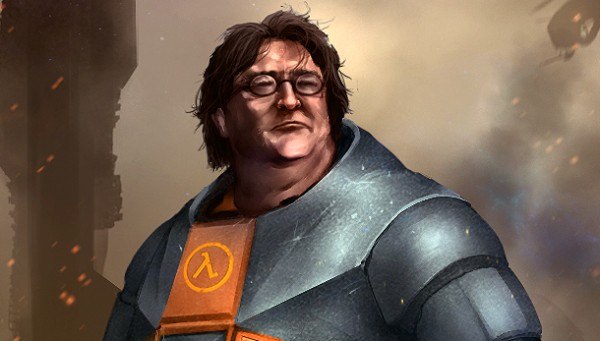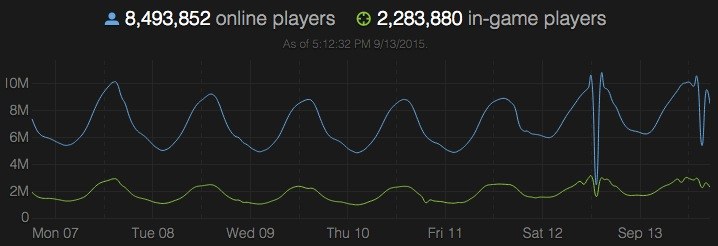WTG, Valve! Steam FTW!!

Valve is currently “pwning” the video game industry with its flagship product, Steam.

Valve is currently “pwning” the video game industry with its flagship product, Steam. This June, Steam broke the 10 million concurrent user milestone and as I write this there are 8.5 million users currently logged into the Steam platform with over 2.2 million players actually in games. But John, you say, that’s over six million players logged in but not playing games; surely a game company should seek to have as many active players as possible. Wrong! Those six million users are precisely why Steam is “roflstomping” the competition. To understand why, we need to hop into Portal’s Time Machine mod and go back to the late 90s / early 2000s. Stay a while and listen.

Back in the day, video game companies like Activision, Capcom, Nintendo, and Konami exclusively wrote static games that were packaged, shipped to retailers, and sold off-the-shelf like a DVD or – in those days – VHS. The model was entirely retail-centric and relied heavily on the manufacture and supply of game disks / packaging. The significant initial capital outlays required to field a game ate heavily into game companies’ profits and raised the financial stakes of game failure. Game companies had to accurately predict how many game disks to manufacture and where to deliver them. Retailers with limited shelf space could sell out and have to backorder additional copies while frustrated gamers fumed at missing out on stealing cars in Grand Theft Auto III. Alternatively, games might sit on shelves for months without selling, further harming profits from an already unpopular game. The marginal cost of software was too high; something had to change.
 Then in 2002 along came Valve and its “
Then in 2002 along came Valve and its “leet” digital distribution platform, Steam. Steam allows users to download games directly over the Internet rather than having to go to GameStop to pick up a hard copy that might not even be in stock. While initially limited to Valve titles, in 2005 third-party games began to appear on Steam, opening the valve on a fire hose of titles that would eventually give Steam a near monopoly on digitally-distributed games. By effectively eliminating marginal distribution costs, Steam not only saved money and reduced downside risk for large game companies but also provided a distribution channel previously unavailable to smaller, independent developers looking to break into the industry.
While Valve does not disclose sales figures for its Steam service, in 2011 analysts estimated that Steam offered game producers 70% gross margins compared to the 30% associated with traditional hard copy distribution [1]. Zero marginal distribution costs also allow developers to capture previously untapped value through one-off sales, bundle packs, and reduced prices for old titles. Lastly, since games are digitally distributed, avid independent developers can create mods for existing big-name games and share them, free-of-charge with the entire Steam community. This creates a tremendous amount of value for all parties involved:
- game companies don’t pay to build the mods = free content
- users often purchase games they otherwise wouldn’t simply because of third-party mods, increasing game companies’ and Valve’s sales
- third-party modders gain exposure and potentially lucrative contracts from big game companies a la IceFrog.

But John, you still haven’t answered my question: why are six million logged in users who aren’t playing games a good thing for Valve? Answer: these users are perusing and commenting on forums, chatting with friends, watching trailers, and, most importantly, shopping for and downloading games. That is, the people making Valve the most money are not the ones playing games but rather those who will be playing games. Advertisers of gaming hardware, gaming companies, movie studios, online tournament hosts, and live-streamers all benefit from perfectly targeting avid gamers without wasting money on TV or general Internet ads. Valve makes money at every turn. At this very moment, Steam users  are downloading 1.1 terabits per second of game content worldwide. That’s a lot of Dota 2, Counter-Strike, Team Fortress 2, and money for Valve. Traditional game retailers, publishers, and console producers beware. The delicious Steam cake is not a lie.
are downloading 1.1 terabits per second of game content worldwide. That’s a lot of Dota 2, Counter-Strike, Team Fortress 2, and money for Valve. Traditional game retailers, publishers, and console producers beware. The delicious Steam cake is not a lie.



I see where you are coming from; there was a similar effect in the video game industry when console gaming moved from expensive cartridges to CDs which were much cheaper to produce. The rise of the CD allowed publishers to make bigger bets with games with fewer risks since it cost much less to make a disc than a cartridge.
One should also remember that Valve was not the first company to try to do digital distribution of video games. Sega actually tried it in 1994 with the Sega Channel, where people connected their Sega Genesis systems through their TV cable on a monthly basis. Sega used this service to deliver a catalog of games that were rotated in and out on a monthly basis, demos of games, contests, and games that were not accessible in other regions such as Alien Soldier. It was canceled after a few years due to Sega deciding to focus on its newer Sega Saturn console. There are other examples as well- such as Atari 2600’s GameLine- but Steam appears to be the best video game download platform in recent memory.
Valve and Steam sure have created a lot of value for the gaming community, but I wonder how much of that value are they capturing? How are they monetizing games purchased by a player from a developer? And if more and more players are downloading Mods, will Steam be able to capture any value there? Lastly, how hard will it be for someone else to replicate an engine like Steam?
Awesome post! I almost wrote about Steam as a digital winner too.
To H’s question about whether someone else could replicate Steam’s success, I believe that Valve has created a platform that benefits greatly from both direct and indirect network effects. Users chat with friends on Steam and enjoy community-generated content like mods and forum discussions, and developers have added Steam-specific content to games like Steam achievements. Given the high switching costs for users (e.g., losing purchases, save files, game stats, and achievements), I don’t see a competitor unseating Steam as the leading digital retailer of PC games any time soon.
Very interesting, John! Steam is certainly a winner by any financial measure, but I’m curious about your contention that it’s also providing ways for both large and small game developers to be winners. I’ve heard about “Steam Sales:” semiannual events where all types of games see steep discounts, often in excess of 90%. They’ve become so prevalent that developers are heavily pressured to participate. It seems as though this devalues newly-released games, giving potential purchasers a reason to “wait until the sale” to actually purchase something. Do you think Valve may be using its effective monopoly position to increase its cachet with game purchasers (i.e., getting a reputation for being the best place to get games cheap) at the expense of developers who may not want to heavily discount their product, or at least may not want people to assume they’ll later be discounting their product? Enjoyed the post! kisses xxoo
To answer your question, I’ll pose my own: where else are small indie game companies going to sell/promote their products if not on Steam? For all intents and purposes, Steam has locked up the market for digital computer (though not yet console) game distribution. Smaller studios use Steam’s enormous network effects to promote their games, even if they get little or no money for them, in hopes of gaining recognition, loyal followers, and social media publicity within the gaming community, ultimately leading to lucrative contracts. If I’m running a small shop, I’d choose to distribute via Steam over some no-name platform or (God forbid) retail chain. I (and Richard Stallman) agree that Steam uses its monopoly position to squeeze developers; but what are their alternatives? It’s be squeezed by Steam and make something or be free and make nothing.
Your point about “wait until the sale” is valid though. This chart (http://ubm.io/1J8YnTz) shows just how much sales events affect game downloads. Some games may state that they’ll never go on sale to discourage gamers from biding their time, but I don’t know that for sure.
Hugs oo
John, you really pwned this blog post.
Steam is amazing, but it would be great to see Valve step up their “game” on the content creation that made them famous. I hope that projects like SteamVR and the Steam Controller can recapture some of this momentum, but I’m skeptical because the best business move is likely to focus on expanding Steam itself.